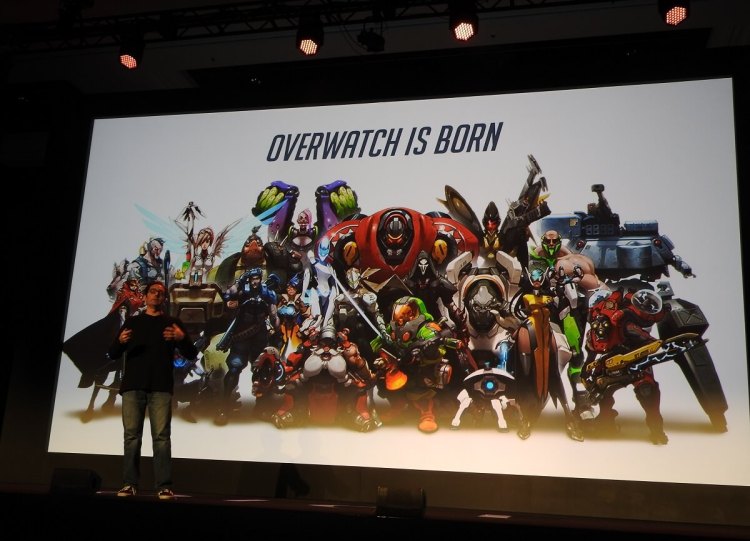Blizzard’s blockbuster game Overwatch is set on Earth, but it’s a place that most people wouldn’t recognize. Set 60 years in the future, the landscapes and maps of the game reflect Blizzard’s own unique vision for how our future will unfold.
Jeff Kaplan described the creative process for building the world of Overwatch in the opening talk at the DICE Summit, the elite game event in Las Vegas this week. The game director’s story showed the behind-the-scenes thinking for building the world of Overwatch, which has sold more than 25 million copies to date.
Kaplan said that Overwatch was born from a failed project, Titan, which was supposed to be the successor to the online game World of Warcraft. Titan started in 2007, but it ran into trouble and was canceled in May 2013. That was painful, as the team had grown to 140 people. Blizzard reassigned 80 to other teams, and 20 moved to other projects. And 40 received a daunting task: coming up with another game idea within six weeks.
It was an emotional time. Mike Morhaime, CEO of Blizzard, said that the core team that remained was a really seasoned group. While they may have felt pressure to come up with a good idea, Morhaime said he had confidence in them. He said that Blizzard had concluded that Titan could not continue as it had in the past, and that something new had to happen.

Above: Titan died, and gave way to Overwatch.
And the team delivered Overwatch. It came from a demoralized team that was barely hanging on, and they created a hopeful world that was inviting and accessible to all. It was different from other visions of the future in gaming, where the surviving postapocalypic worlds is routine.
“It was a devastated mind set that the team was in,” Kaplan said.
The team’s attention was drawn to the work of artist Arnold Tsang. These were stylized, cartoon-like images of characters who were heroes. Some of them came from the Titan work, and others started thinking about what the world — Planet Earth, rather than Titan — could look like in 60 years.

Above: Jeff Kaplan talks about building Overwatch at DICE Summit 2017. These characters were the work of Arnold Tsang.
The team considered realistic games like Call of Duty and postapocalyptic games like The Last of Us.
“It didn’t feel like there was a lot of breathing room,” Kaplan said.
The team had learned from making The Burning Crusade expansion pack for World of Warcraft that players could get tired of dark worlds. They often sought out the areas of the fantasy world that were less stressful and more light-hearted.
“We found out over time environments like this can be oppressive and fatiguing to players,” Kaplan said.
So the team focused instead on making a world that was accessible and where everyone was welcome. You can see this in Overwatch’s map of Iraq. Rather than a dusty place with bombed-out buildings, Iraq is a modern place rebuilt with the most advanced technology in the world.
“Could we imagine a better future for Iraq?” Kaplan asked. “The cliche is fantasy is greater than reality.”
In favor of fun, the team tossed realism out the window. The Hollywood map, for instance, resembles what someone from Belgium might think Hollywood looks like.
In creating the Dorado map, which is set in Mexico, the team visited places like Mexico City. They wanted to have hills, a coast, and they found a cool place via Google Images via a search for “a colorful Mexican town.” Then someone noticed this city was actually Manarola, Italy, and wasn’t in Mexico at all.
“Overwatch is more about the heroes than anything else, and they are part of the world-building process,” Kaplan said.
The team also wanted to embrace differences. That sparked a lot of discussion about diversity, as it was a hot topic in the game industry while the game was being made.
“We were praised and criticized for our decisions,” Kaplan said. “A lot of people thought diversity was the goal of the Overwatch team. The goal was inclusivity and open mindedness. Diversity was the result. We wanted to make a world that was accessible to all.”

Above: Overwatch box cover
One character, Tracer, is a female hero who had a girlfriend at home, rather than a boyfriend.
“To us, what was important about Tracer was she was this bad-ass time-traveling hero,” Kaplan said.
In the end, the Overwatch team’s experience turned out to be a comeback story.
“We didn’t get dispersed to the winds,” Kaplan said. “I want to remind people. We built Overwatch from a selfish place. You had a team with little hope and a lot of despair. Failure is a dark situation. To pull ourselves out of that dark situation, we created a hopeful world. We need to show people what the world could be like. This shows there is room for hopefulness and inclusivity in our industry as well.”

Above: The Overwatch team

